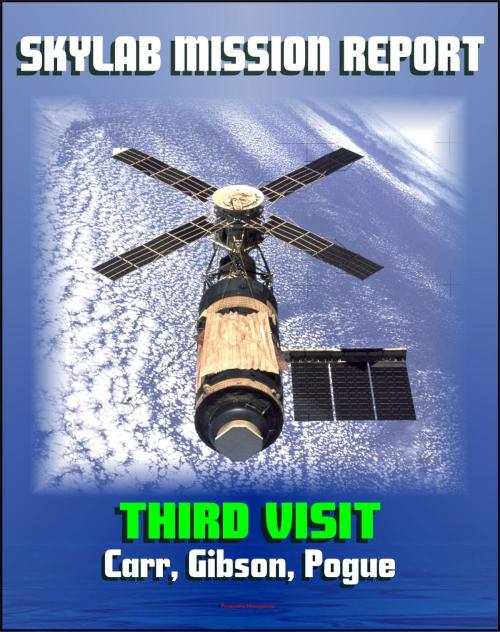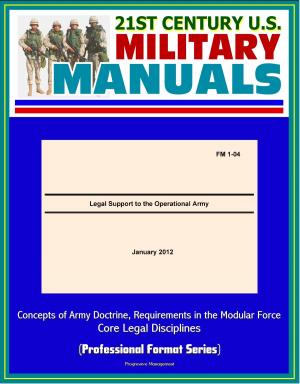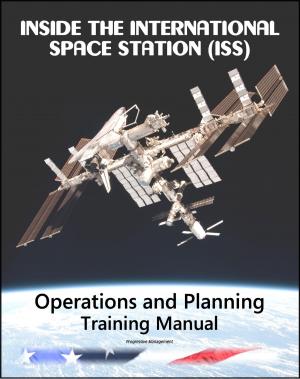Skylab Mission Report: Third Visit - Space Station Mission by Carr, Gibson, Pogue, Mission Activities, Hardware, Anomalies, Science Experiments, Crew Health, EVAs, Comet Kohoutek
Nonfiction, Science & Nature, Technology, Aeronautics & Astronautics, Science, Physics, Astrophysics & Space Science| Author: | Progressive Management | ISBN: | 9781476116945 |
| Publisher: | Progressive Management | Publication: | May 19, 2012 |
| Imprint: | Smashwords Edition | Language: | English |
| Author: | Progressive Management |
| ISBN: | 9781476116945 |
| Publisher: | Progressive Management |
| Publication: | May 19, 2012 |
| Imprint: | Smashwords Edition |
| Language: | English |
This official NASA internal document - converted for accurate flowing-text ebook format reproduction - is a comprehensive evaluation of the operational and engineering aspects of the third manned visit to the Skylab space station and includes the performance of experiment hardware that is under Johnson Space Center management; the crew's evaluation of the visit; and other visit-related items of interest such as medical aspects and hardware anomalies.
The third visit space vehicle was launched at 14:01:23 G.m.t. (9:01:23 a.m. e.s.t.) on November 16, 1973, from Launch Complex 39B at the Kennedy Space Center, Florida. The vehicle was manned by Lt. Col. Gerald P. Carr, Commander; Dr. Edward G. Gibson, Scientist Pilot; and Col. William R. Pogue, Pilot. The launch was originally scheduled for November 10, 1973; however, an inspection of the launch vehicle revealed cracks in the first stage fins and the decision to replace all of the fins necessitated the launch delay. The planned duration of the visit was 56 days with the option of extending it to a maximum of 84 days, which was achieved.
Orbital activities included four periods of extravehicular activity totaling approximately 22 1/4 hours. The first extravehicular activity was accomplished on visit day 7 and lasted 6 hours 34 minutes. The primary purpose of the activity — installation of film magazines in the Apollo Telescope Mount cameras — was accomplished satisfactorily. Other tasks accomplished included performing corrective maintenance on the experiment S193 (Microwave Radiometer/Scatterometer and Altimeter) antenna, deploying panels of experiment D024 (Thermal Control Coatings), deploying impact detectors of experiment S149 (Particle Collection), deploying detector modules of experiment S228 (Trans-Uranic Cosmic Rays), and deploying collector assemblies of experiment S230 (Magnetospheric Particle Composition).
The second and third extravehicular activities were conducted on visit days 40 (Christmas Day) and 44 to allow extravehicular photography of the Comet Kohoutek prior to and after perihelion. The instruments for experiments S201 and T025 were used for this purpose. Experiment S020 (X-Ray/Ultraviolet Solar Photography) was also conducted on the second and third extravehicular activities. Other tasks performed during the visit day 40 extravehicular activity consisted of replacing film magazines in the Apollo Telescope Mount cameras, pinning open the door of experiment S082A (Extreme Ultraviolet Spectroheliograph), manually repositioning the filter wheel on experiment S054 (X-Ray Spectrographs Telescope), and retrieving experiment S149 impact detectors. The duration of the second extravehicular activity was 6 hours 54 minutes, and the duration of the third extravehicular activity was 3 hours 29 minutes.
The fourth and final extravehicular activity was performed on visit day 80. The major tasks accomplished consisted of retrieval of the Apollo Telescope Mount film, an additional performance of experiment S020, and performance of experiment T025. Other tasks consisted of retrieval of modules, panels, assemblies and samples that were to be returned to the ground for analysis, and deployment of cassettes and panels for potential retrieval in the future. The duration of the fourth extravehicular activity was 5 hours 19 minutes.
This official NASA internal document - converted for accurate flowing-text ebook format reproduction - is a comprehensive evaluation of the operational and engineering aspects of the third manned visit to the Skylab space station and includes the performance of experiment hardware that is under Johnson Space Center management; the crew's evaluation of the visit; and other visit-related items of interest such as medical aspects and hardware anomalies.
The third visit space vehicle was launched at 14:01:23 G.m.t. (9:01:23 a.m. e.s.t.) on November 16, 1973, from Launch Complex 39B at the Kennedy Space Center, Florida. The vehicle was manned by Lt. Col. Gerald P. Carr, Commander; Dr. Edward G. Gibson, Scientist Pilot; and Col. William R. Pogue, Pilot. The launch was originally scheduled for November 10, 1973; however, an inspection of the launch vehicle revealed cracks in the first stage fins and the decision to replace all of the fins necessitated the launch delay. The planned duration of the visit was 56 days with the option of extending it to a maximum of 84 days, which was achieved.
Orbital activities included four periods of extravehicular activity totaling approximately 22 1/4 hours. The first extravehicular activity was accomplished on visit day 7 and lasted 6 hours 34 minutes. The primary purpose of the activity — installation of film magazines in the Apollo Telescope Mount cameras — was accomplished satisfactorily. Other tasks accomplished included performing corrective maintenance on the experiment S193 (Microwave Radiometer/Scatterometer and Altimeter) antenna, deploying panels of experiment D024 (Thermal Control Coatings), deploying impact detectors of experiment S149 (Particle Collection), deploying detector modules of experiment S228 (Trans-Uranic Cosmic Rays), and deploying collector assemblies of experiment S230 (Magnetospheric Particle Composition).
The second and third extravehicular activities were conducted on visit days 40 (Christmas Day) and 44 to allow extravehicular photography of the Comet Kohoutek prior to and after perihelion. The instruments for experiments S201 and T025 were used for this purpose. Experiment S020 (X-Ray/Ultraviolet Solar Photography) was also conducted on the second and third extravehicular activities. Other tasks performed during the visit day 40 extravehicular activity consisted of replacing film magazines in the Apollo Telescope Mount cameras, pinning open the door of experiment S082A (Extreme Ultraviolet Spectroheliograph), manually repositioning the filter wheel on experiment S054 (X-Ray Spectrographs Telescope), and retrieving experiment S149 impact detectors. The duration of the second extravehicular activity was 6 hours 54 minutes, and the duration of the third extravehicular activity was 3 hours 29 minutes.
The fourth and final extravehicular activity was performed on visit day 80. The major tasks accomplished consisted of retrieval of the Apollo Telescope Mount film, an additional performance of experiment S020, and performance of experiment T025. Other tasks consisted of retrieval of modules, panels, assemblies and samples that were to be returned to the ground for analysis, and deployment of cassettes and panels for potential retrieval in the future. The duration of the fourth extravehicular activity was 5 hours 19 minutes.















